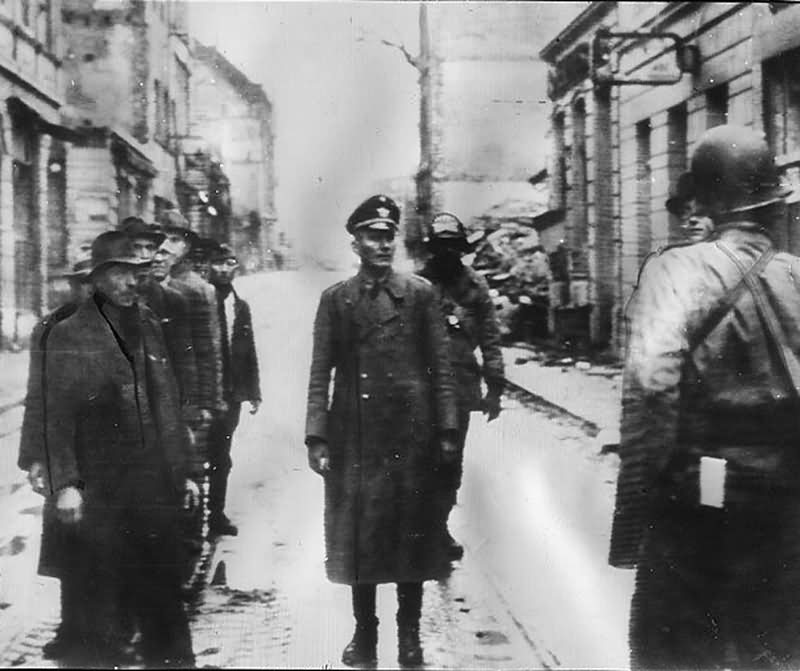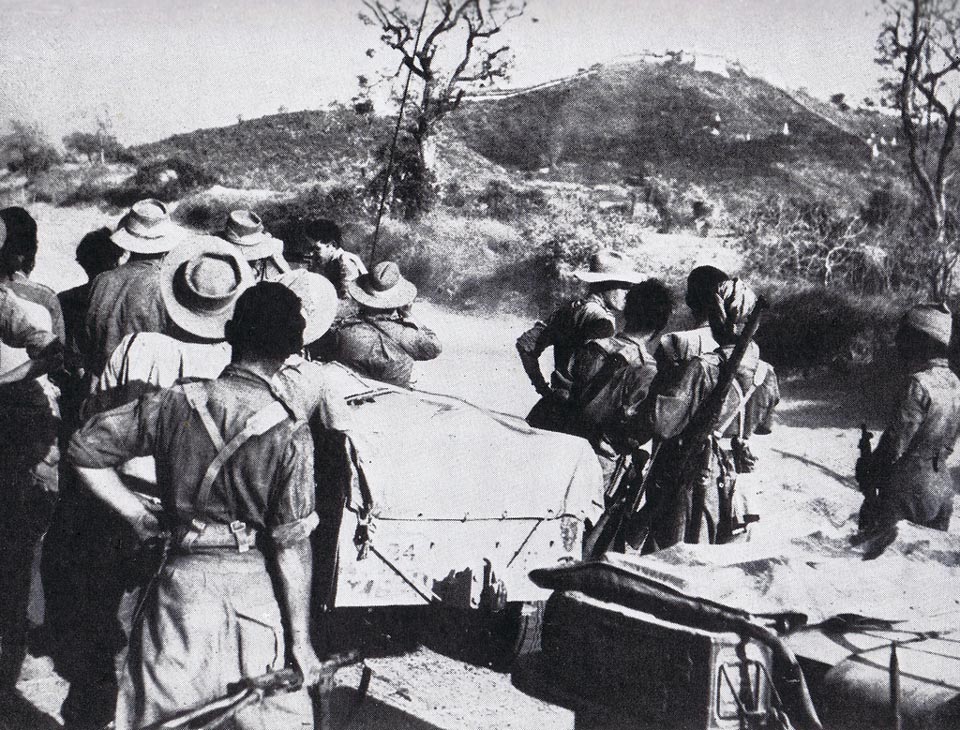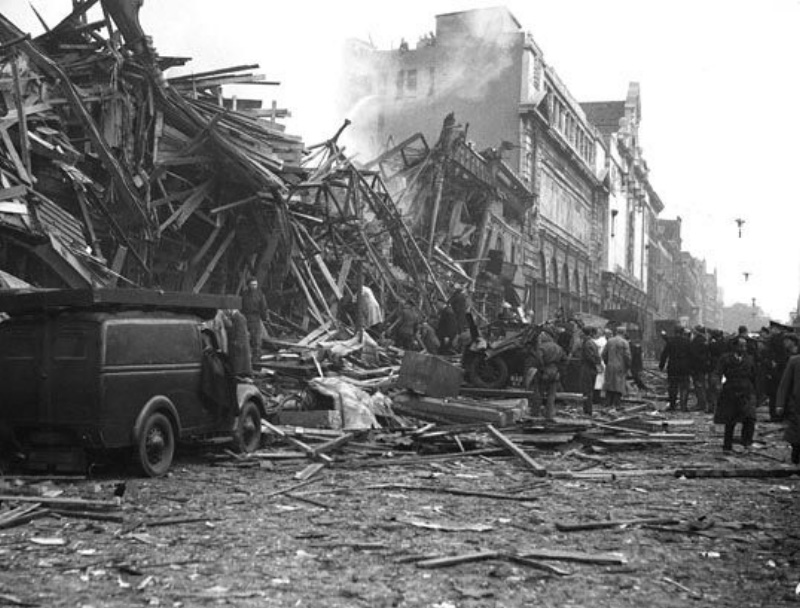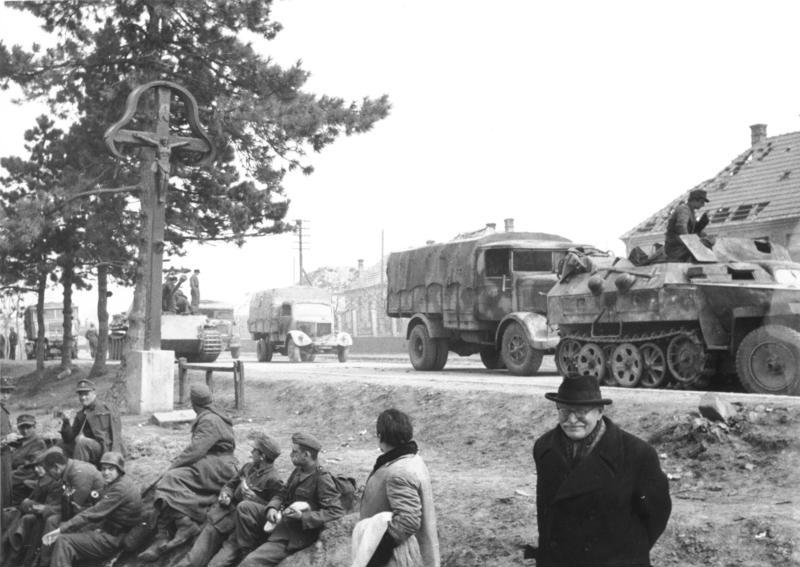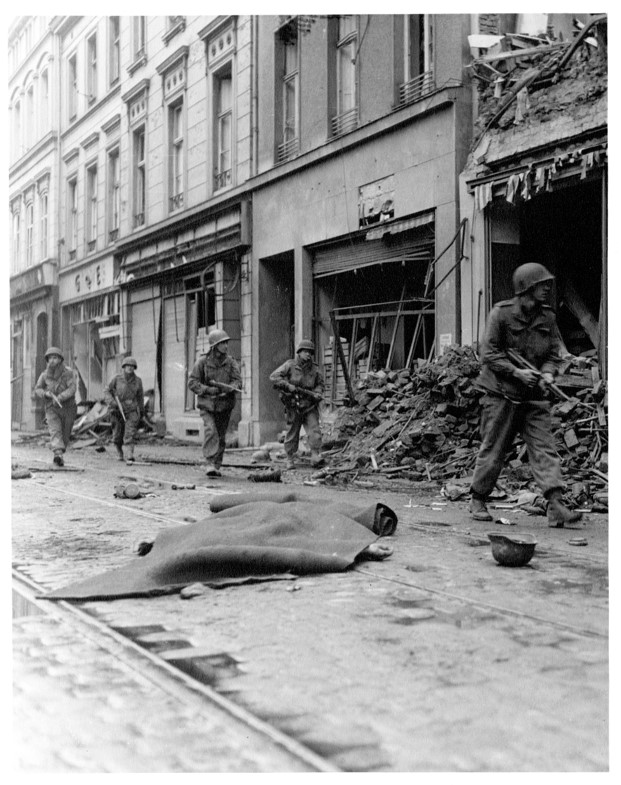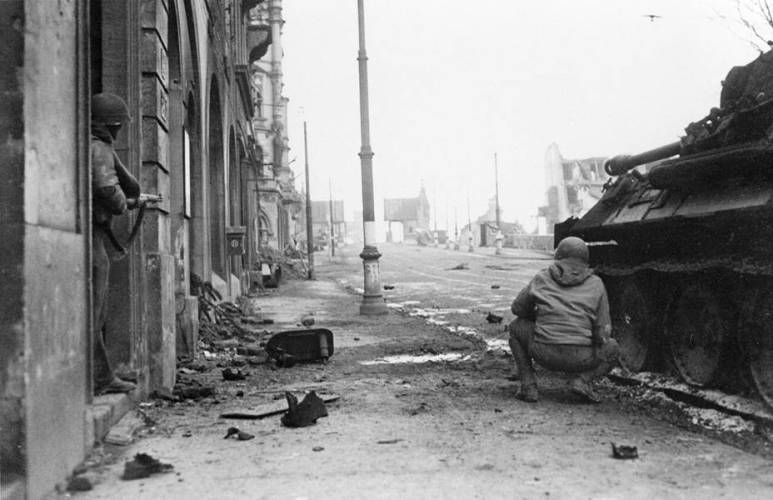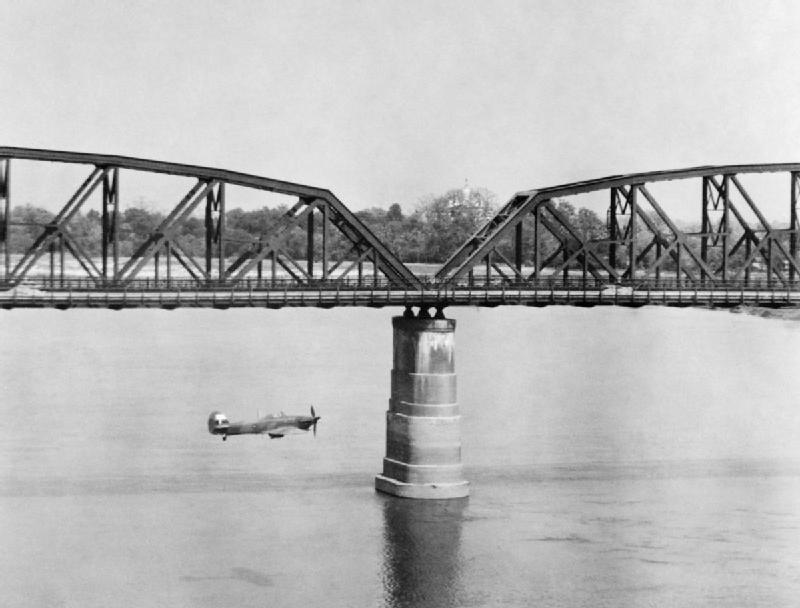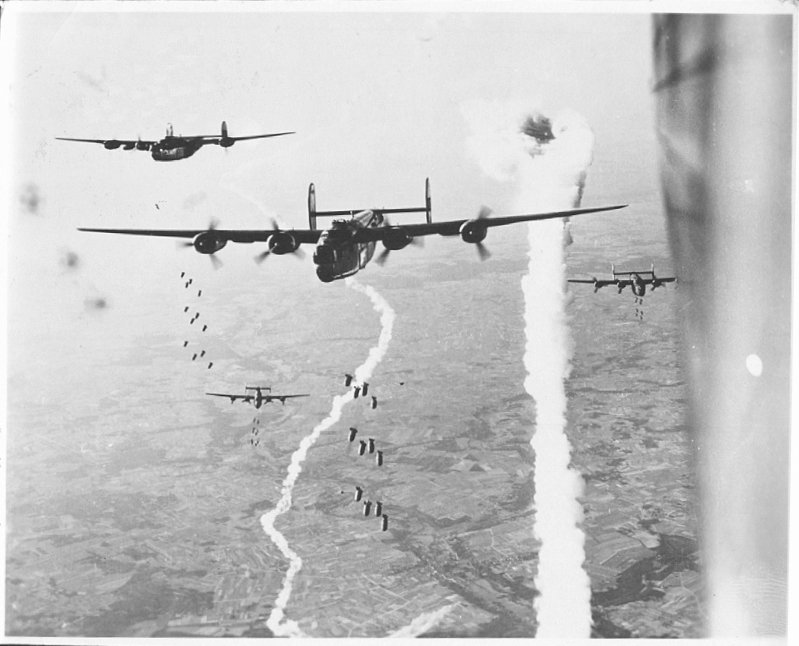Air Operations, CBI
BURMA- 40 10th Air Force fighter-bombers attack troops and supplies in and directly behind the Japanese Army battle lines.
- 39 fighter-bombers sweep roads and attack artillery positions and targets of opportunity.
- 20 P-47s support British 14th Army ground forces near Mogok.
- 34 308th Heavy Bomb Group B-24s and 21 14th Air Force P-51s attack Shihkiachwang.
- 3 B-24s attack a transport in the South China Sea.
- 16 341st Medium Bomb Group B-25s and 6 P-40s attack bridges and rail targets in and around Chungmow, Hengshan, Lohochai, and Yehhsien.
- More than 140 fighter-bombers attack numerous targets across southern and eastern China.
Air Operations, Europe
A V-2 kills 110 and seriously injure 123 at Farringdon Market, London.
RAF BOMBER COMMANDEvening Ops:
- 312 aircraft includin 241 Halifaxes, 62 Lancasters and 9 Mosquitos of Nos, 4, 6 and 8 Groups attack Hamburg. The purpose of this raid is to hit the shipyards which are now assembling the new Type XXI U-boats, whose parts are prefabricated in many parts of inland Germany. Thanks to the Schnorkel breathing tube and a new type of battery-driven electric engine, the Type XXI could cruise under water for long periods and was capable of bursts of high speed. Its development in numbers would pose great problems for Allied convoy defense if the war lasts longer. The Hamburg area is found to be cloud-covered and the bombing is not expected to be accurate enough to cause much damage to the shipyards.
- 1 Halifax is lost.
- 262 Lancasters and 14 Mosquitos of Nos. 1 and 8 Groups carry out the first large raid on Kassel since October 1943. It ias also the last large RAF raid on this target. This target is also covered by cloud.
- 1 Mosquito is lost.
- 39 Mosquitos are sent to Berlin, 33 to Hannover, 7 to Hagen, and 5 each to Bremen and Osnabrück, 23 Halifaxes and 14 Lancasters lay mines in the Elbe and Weser Rivers, 5 aircraft make Resistance flights, and there are 36 Mosquito patrols and 50 RCM sorties. The 5 Stirlings of No. 161 Squadron, which are carrying supplies to Resistance units at unrecorded destinations, but probably in Denmark and Norway, are the last Resistance operations flights of the war.
- 1 RCM Halifax is lost.
GERMANY:
- 337 1st Air Division B-17s attack synthetic-oil plants at four locations.
- 109 1st Air Division B-17s attack a marshalling yard at Essen (target of opportunity).
- 257 2nd Air Division B-24s attack marshalling yards at three locations.
- 272 3rd Air Division B-17s attack three synthetic-oil plants at two locations.
- 122 3rd Air Division B-17s attack a chemical plant.
- 33 heavy bombers attack various targets of opportunity.
GERMANY:
- 328 9th Air Division bombers attack two marshalling yards, communicatins centers at seven locations, an overpass, and a military transport depot.
ITALY:
- 12th Air Force B-25s attack a marshalling yard, a bridge, and two rail fills.
- XXII TAC P-47s attack supply dumps, a munitions factory, an industrial comple, and lines of communication.
- During the night, XXII TAC A-20s and A-26s attack river crossings in the Po River valley.
AUSTRIA:
- 15th Air Force heavy bombers attack a steel works at Kapfenburg.
- 15th Air Force heavy bombers attack marshalling yards at two locations.
- 15th Air Force heavy bombers attack a marshalling yard at Verona.
- 15th Air Force heavy bombers attack a locomotive depot at Maribor.
Air Operations, Philippines
- XIII Bomber Command B-24s, 42nd Medium Bomb Group B-25s, and 347th Fighter Group P-38s attack targets in the Zamboanga area.
- V Bomber Command B-24s attack road targets around Balete Pass.
- V Bomber Command A-20s support Filipino guerrilla forces in the San Fernando area.
- FEAF fighter-bombers attack numerous targets.
- A VMF-115 F4U patrolling over the Calarian airfield on Mindanao downs a Ki-44 'Tojo' fighter at 0930 hours.
Air Operations, Volcano Islands
Guided by a VC-84 TBM, 15th Fighter Group P-51s mount their first mission in support of US V Marine Amphibious Corps ground forces on Iwo Jima.
[Burma
The 2nd British and 20th Indian Divs begin to break out of their bridgeheads over the Irrawaddy to the west of Mandalay.
[Diplomatic Relations
Secret talks begin between Allen Dulles, OSS intelligence chief in Bern, and Karl Wolff, SS commander in northern Italy, on ending the war in Italy. Field Marshal Kesselring is willing to stop fighting if the forces under his command could be repatriated and fight with the Allies in Germany against Russia. Stalin, when he learns of the talks, accuses Britain and the US of duplicity.
[Eastern Front
Fighting goes on south of Stettin and Danzig as well as in Silesia, while in Hungary and Yugoslavia the German 6th SS Panzer Army presses on from Székesfehérvár toward the Danube and along the Sarviz Canal, and the 2nd Panzer Army, south of Lake Balaton, advances on Nagybajom. The Germans have so far made penetrations of from 6 to 15 miles.
The German Army Group E engages the Bulgarian and Yugoslav forces across the Drava and contains the Yugoslav forces west of Sarajevo.
HUNGARYSPRING AWAKENING is faltering, with the II SS Panzer Corps being held by the 26th Army and the 2nd Panzer Army by the 57th Army.
[Germany, Home Front
Hitler decrees: 'Anyone captured without being wounded or without having fought to the limit of his powers has forfeited his honor. He is expelled from the fellowship of decent and brave soldiers. His dependents will be held responsible.'
[Italy
The 1st Arm Div, US II Corps, 5th Army, carries out limited attacks to reinforce the positions of the Corps' left flank, taking Carviano, northeast of Vergato.
[Iwo Jima
The 3 Marine divisions renew their attacks against the Japanese positions with support from artillery and flame-throwers, winning a few hundred yards all along the line. The 4th Marine Div then drives off a violent Japanese counterattack. The Americans observe that the number of suicides among the enemy dead has greatly increased
an encouraging sign for the Allies.
[Pacific
The Japanese transport No. 143 is sunk by US Army aircraft in the Formosa area.
[Philippines
On Luzon the US XIV Corps continues its attacks on the Shimbu line with the 6th Div and the 1st Cav Div and some progress is made toward Antipolo. In the I Corps area the Americans capture Mount Magabang, northeast of Aringay, and the village of Putlan.
All organized Japanese resistance ceases on Palawan Island. The Americans also occupy the islets of Busuanga, Balabac and Pandanan.
[United States, Command
Vice-Adm William Ward Smith take command of the Service Force, US Pacific Fleet. The Service Force has a massive job in providing logistics support to US operations in the Pacific. Smith was formerly chief of staff to Adm Kimmel, and commanded a cruiser task group that saw action in the battles of Coral Sea and Midway.
[Western Front
After meticulous preparation, the British 43rd and Canadian 2nd Divs, Canadian II Corps, 1st Army, launch an attack on Xanten, which they take.
In the US 1st Army sector, the 1st Div, VII Corps, pushes on toward the Rhine opposite the city of Bonn.
At Remagen the III Corps is engaged with every means available in reinforcing and extending the bridgehead over the Rhine, however, the haste with which the operations have to be mounted does lead to some lack of coordination and to congestion on the routes leading to the bridge. The Germans too are making desperate attempts to plug the leak at Remagen; within 2 days, more than 300 Luftwaffe aircraft carry out dive-bombing attacks on the bridge in attempts to destroy it, but in vain. The VIII Corps of the US 3rd Army advances rapidly toward the Rhine.
There are still German garrisons in the Channel Islands, and during the night they mount a raid on Granville on the west coast of the Cotentin. One small US warship is sunk and 4 merchant ships. 67 prisoners of war are freed in the raid.
[Images from March 8, 1945
|
|
|
|
|
|
|
|
